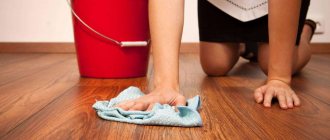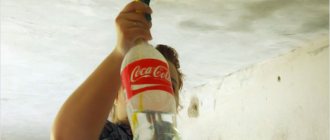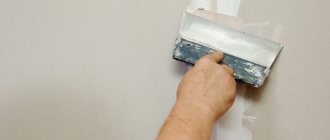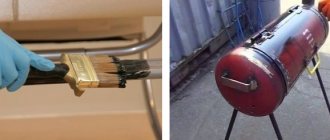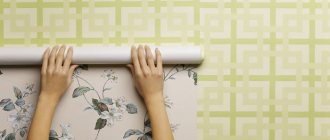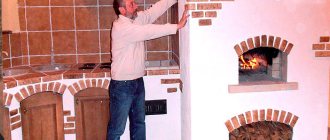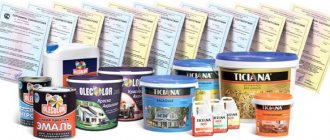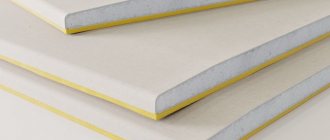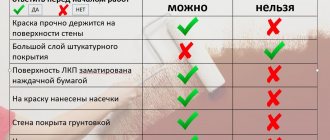Water-based paints are popular, they are inexpensive and the coating has good quality characteristics. Working with paints is easy; you can carry out repair work yourself without turning to specialists for services. To understand what properties and features this paint and varnish material has, it is necessary to understand the paint parameters according to GOST. It specifies all the required characteristics. They will be described in more detail below.
Characteristics of water-based paints according to GOST
GOST 28196 89 prescribes water-dispersion paints technical conditions that must be present in the manufactured product. Water emulsion can be used for a variety of purposes; different types of compositions are produced that differ in different properties.
To obtain a variety of properties and improve the paint, manufacturers add additional components. The basis can also be different elements, among them acrylic, which is known for its good properties. There are separate paints for facades and interior works. They are used for painting walls and ceilings. According to GOST, the characteristics of four types of paints are prescribed:
- VD VA 224, the maximum content of non-volatile elements in the composition varies from 53% to 59%. The ability to cover a surface with color is 120 grams per square meter of surface. Resistance to moisture is 12. pH ranges between 6.8 and 8.2. The maximum amount of freeze exposure is 5. Light resistance is not inherent. Complete drying under acceptable conditions lasts 60 minutes;
- VD AK 111, amount of non-volatile substances 52-57%, pH cannot be more than 9.5. The hiding power is approximately 100 grams per sq.m. Exposure to liquids is 24. Freezing is possible up to five times. Light resistance is five, drying takes 60 minutes;
- VD AK 111r. Non-volatile substances can be present at no more than 47-52%, pH varies from 7.5 to 9.5. Covering power is estimated at about 80 grams per m2. Moisture resistance -24. Resistance to freezing cycles and light fastness – 5. Drying lasts 60 minutes;
- VD CN 183 contains non-volatile elements in an amount of 52-57%. pH approximately 8. Coverage rate 120g/m2. Moisture resistance 24. Freeze up to five times. Light resistance 5, drying takes 60 minutes.
Water emulsion can be used for a variety of purposes; different types of compositions are produced that differ in different properties.
Non-flammable paint for escape routes class km0
Ensuring fire safety is one of the key tasks in the construction and operation of modern high-rise buildings, large business centers and shopping and entertainment complexes.
Particular attention today is paid to buildings:
- hospitals,
- orphanages
- nursing homes,
- schools,
- kindergartens
- other similar buildings.
The specificity of such buildings - the large length of evacuation routes (corridors, flights of stairs, etc.) - dictates increased requirements for fire safety of the building structures and materials used.
And only when these requirements are met along with the solution of other technical and economic problems, the building is considered to be designed and constructed correctly.
According to the Federal Law of the Russian Federation dated July 22, 2008 No. 123-FZ “Technical Regulations on Fire Safety Requirements”, the choice of building materials directly depends on the functional purpose of the building or premises.
From a fire safety point of view, the optimal classification is proposed in Article 13 of the Technical Regulations, which divides building materials into two types: combustible and non-combustible.
In addition, they are assessed according to criteria such as
- flammability,
- ability to spread flame over a surface,
- smoke generating ability
- toxicity.
The combination of these indicators allows us to assign a fire hazard class to a specific material:
- from KM0 – for non-combustible materials
- up to KM1-KM5 – for combustibles.
Decoding GOST parameters
To understand what the marking letters and numbers on the product mean, you need to understand their decoding. In general, the average person may not need this information. The main thing is to understand that the presence of a certain marking guarantees the purchase of a quality product; GOST was complied with during the production of the product.
The letters VD mean a water-dispersed paint composition; there may be products with the letters BA, which means that polyvinyl acetate dispersions were used as a component. The following marking letters refer to the type of polymer components of the product; most often you can see CN - indicating the presence of butadiene styrene. Or AK - styrene acrylate.
The number is written last, there are only a few of them, it won’t take long to remember. Either the number 1 or 2 is entered. The first is intended for work inside the building, the second for work outside. This marking makes selection easier. Products intended for outdoor use are resistant to natural factors.
If no marking is found, then the product does not have a quality certificate; you should not choose a similar product; the likelihood of obtaining the properties declared by the manufacturer on the packaging is minimal.
Products intended for outdoor use are resistant to natural factors.
Brands and technical requirements
To make choosing a type easier, you can figure out what purpose each is intended for. The selection should be made taking into account the working conditions and further operating conditions of the coating. Water-dispersion paints and other GOST. There are several main ones, which will be discussed further.
- VD VA 224, intended for painting the surface inside a building, can be used in rooms where the humidity level is high;
- VD KCh 26a and 26 are applied for interior wall decoration;
- VD AK 111, VD AK 111r are suitable for façade painting of building walls and for finishing interior walls. You can get a relief coating;
- VD KCh 183 are also suitable for work outside and inside the structure, however, if no further washing is expected;
- VD KCh 577 is a special type for painting trees before wintering, in order to create protection against pests and treat wounds.
The selection should be made taking into account the working conditions and further operating conditions of the coating.
Preparing surfaces for painting
Metal preparation - they say that water-based paints do not adhere to metal, but GOST contains a link to GOST 8832, which clearly states the basic requirements.
- If there are traces of rust, tarnish or scale on a metal such as steel or black tin, the metal layer is cleaned to a depth of 0.7 microns.
- Steel and black tin are sanded using sandpaper and grinding wheels with grit 4 - 6.
- After mechanical processing, the metal should be treated with nefras and white spirit using soft cotton cloth.
- Next, wait for the surface to dry completely.
With aluminum and alloys, aluminum and copper foil, tinplate, the same degreasers are used, as well as acetone. The difference is that these metals must then be wiped dry before they can be left to dry.
Before applying paint, glass is washed in a warm soapy solution, and then in clean water, and either wiped dry or left to dry.
Wood and wood materials are sanded with 5-6 grit sandpaper and then the dust is removed with compressed air. Check how dust-free the surface is using a clean cotton swab.
Another basic rule is to apply it to a dry, free of all kinds of contaminants surface. The film created by the previous finishing material on the surface of the wall/ceiling is removed.
Application of GOST paint indoors
- Old coatings are pre-washed with soda solutions (3%; 1 tbsp: 1 l) or ordinary soap, or washing powder, as well as an ammonia solution.
- Chalk, lime and materials based on them are completely cleaned off, sometimes washed off (in new buildings; multi-layer old coatings are very difficult to wash away).
- The crumbling layers are completely removed.
- The paint is tinted in light colors using water-based colors.
Application of GOST paint on facades
One of the important rules: facades should be painted at air and substrate temperatures above +8 °C.
The drying time for layers set by the manufacturer is valid at air temperatures above +15 °C. At lower temperatures, the drying time for each layer is increased to 24 hours.
Preparing the facade for finishing
- Set the degree of deformation of the base.
- We inspect the finishing layer and evaluate its strength, pay close attention and establish at least approximately the degree of absorption, pH, make sure that there is no efflorescence, and identify a high level of soluble salts, if any.
- It is calculated how much moisture enters the wall and where it comes from, and measures are taken to block the rise in groundwater levels and minimize capillary suction.
- The need to use biocides and fungicides for treating facades is assessed, including such compounds as anti-mold and anti-bug, which are very relevant for wooden facades.
- The vapor/gas permeability of the base is a very important characteristic: the choice of finishing materials depends on it. Thus, limestone surfaces should be coated with paints that allow carbon dioxide to pass through - for example, organic silicon. In order not to interfere with carbonization - hardening of lime materials when interacting with carbon dioxide. But for reinforced concrete structures, carbonization is unacceptable, so acrylic paints are excellent for them.
- If the finishing does not prepare the building for delivery, but is used to update the appearance more than once, then the compatibility of materials (last used for renovation and new ones that are planned to be used now) is clarified in advance.
- The air is also analyzed: it is better to take into account how clean/dirty the atmosphere may be in order to choose a more/less vapor-permeable material that is highly resistant/not resistant to aggressive environments.
- It is a long-standing truth that tinted paint and the final coat should not be thinned. Also, it is very risky to dilute the paint by more than 15% of the volume - this is the maximum. As a rule, paint manufacturers recommend diluting their product by only 5%. From experience, undiluted paint looks better on the surface. It is better to prime and thin 1 coat well to give the topcoat all its benefits.
- When carrying out work, take into account temperature, humidity, wind, threat of precipitation, how warm/cold the base is, etc.
- If the environment is quite heavily polluted (including exhaust gases), the object is located in an aggressive industrial zone, or acid rain occurs - in this case, you should buy paint that is resistant to contact with acids and alkalis.
GOST still remains the standard in many industries. But time takes its toll, and qualitatively new trains and equipment appear. Also, for some manufacturers, especially in the luxury segment, the GOST framework is becoming narrow. Therefore, they are preparing new standards for their products.
Safety requirements
In accordance with GOST, this paint is fireproof. During production, a good level of ventilation must be created in the building. The composition contains elements harmful to human health. They do not wear out after the drying stage is completed.
While working, the master must wear protective equipment to avoid health problems.
During production, a good level of ventilation must be created in the building.
Acceptance rules
Acrylic paint, in accordance with GOST 28196 89, must be checked by the manufacturer for a number of important parameters, which are specified in the document and are checked once every 30 days. The manufacturer must check three batches at a time. There are a number of requirements that are checked periodically if there is a request from the consumer.
If a discrepancy is detected during the check, then it lasts until the moment when the error is not absent in 6 games in a row.
The manufacturer must check three batches at a time.
Test methods
Before verification tests of the resulting product begin, the number of elements contained and frost resistance indicators are determined. Tests must demonstrate the quality of the product and identify inconsistencies if they exist. For this purpose, special devices and equipment are used. Only a tested product can have a marking and a quality certificate; they guarantee that the declared properties will be obtained as a result after painting.
Tests must demonstrate the quality of the product and identify inconsistencies if they exist.
Transportation and storage
Acrylic paint according to GOST and other types are packaged in plastic containers of different volumes. They do an excellent job of storing the composition. If there is very little product left in the bucket, you can pour it into a smaller container, be sure to close the lid tightly to avoid evaporation of water and drying out of the paint. The paint can be stored at temperatures from +0 to +30 degrees, up to 1 year.
The paint can be stored at temperatures from +0 to +30 degrees, up to 1 year.
General information
The material is based on a group of substances - polyacrylates (mainly polymers of methyl, ethyl and butyl acrylates). These paints are water-dispersed, which makes them possible to dilute with water. The color of the composition is determined by the addition of certain pigments to it.
Paint is used in repair work on a wide variety of surfaces, both indoors and outdoors. In addition, acrylic paints are also very relevant in painting, but we will bypass this option today.
Directions for use
Before painting, prepare the surface itself; you need to proceed in stages. Clean it from all types of contaminants. If there is an old coating that does not adhere well, it is removed. If chalk or limescale paints have been applied, they must also be removed from the wall.
Before painting, prepare the surface itself; you need to proceed in stages.
If necessary, the paint is diluted with water before use; follow the instructions on the package. The composition should be stirred well before application. If you choose white paint, but you need to get a different shade, you can add a suitable color.
You can apply the paint with a brush, roller or spray gun. Apply 1-2 layers to the surface until a uniform color is obtained. If you are going to create a relief coating, then coarse sand is added to a suitable type before work. It will help you get a spectacular finish.
You can work with GOST facade paint at temperatures from +8 degrees. At temperatures below +15 degrees, it is advisable to leave the layer to dry for a day.
Apply 1-2 layers to the surface until a uniform color is obtained.
How to decide on color
First of all, it should be noted that acrylic paint is perfectly tinted. To do this, you just need to purchase white paint and then add dye to it. You can read more about how to tint paint and varnish products in the material dedicated specifically to this process.
If your renovation is not a designer one or there are no special color requirements, then you can use standard options and save time on tinting work.
manufacturer's warranty
The manufacturer who has received a quality certificate guarantees that he has complied with all GOST requirements. And the paint will have the appropriate characteristics if the rules of transportation and storage are followed. The shelf life of the composition is one year.
The manufacturer who has received a quality certificate guarantees that he has complied with all GOST requirements.
Purchasing only a quality product can guarantee a beautiful finish that is safe and will last a long time. When purchasing, pay attention to the labeling, or ask the seller for a quality certificate. There are a lot of fakes on the construction market; you should take the choice of product seriously. There are many types of products, you can easily find a suitable option.
FAQ
Which paint is better, latex or acrylic?
Acrylic and latex paints have much in common in their characteristics and composition. But there are differences that need to be taken into account when choosing a coating.
You should start with the purpose. If an acrylic-based material is suitable for ceilings and walls, then when purchasing latex paint you need to know exactly the type of base to select the correct composition. It contains various additives that give additional properties and wear resistance to the painted surface.
Comparative analysis of paints
| Evaluation Properties | Acrylic | Latex |
| Solvent type | water + special compounds | water |
| Moisture resistance | + (without direct contact of water with the surface) | + (not afraid of direct contact with water) |
| Ability to mask defects | smooths out minor roughness | hardly hides flaws |
| Resistance to temperature changes | high | low |
When looking for an affordable option in price, the choice falls on latex coating.
Coping with the application of acrylic material will not be difficult. Latex paint requires adherence to technology. A surface painted with acrylic is considered to be of higher quality and resistant to temperatures and other factors. Therefore, experts advise using this particular type.
How to clean acrylic paint from a brush?
It is recommended to wash your brushes immediately after finishing painting. This allows cleaning to take place quickly using only water. There is no need to leave the instrument in the liquid for a long time. Due to prolonged exposure to a humid environment, the shaft may begin to deteriorate and the pile may deteriorate. To wash acrylic paint brushes, use warm water, soap or dishwashing detergent. If you can’t wash your brushes immediately after painting, you shouldn’t peel off the dried coating with a knife or stick. It is enough to dip the tool into a container with acrylic solvent to soften the crust. The brush should be installed so that the place where the bristles are attached is not immersed in the solvent. Next, wash with warm soapy water. Turpentine will help remove old paint.
The difference between acrylic paint and regular water-based paint?
Despite the fact that both types of paint are water-soluble, their characteristics have many differences. Acrylic-based coating is more resistant to humid environments and high temperatures. Thanks to the properties of acrylic resins, the formation of cracks on the painted surface is eliminated. The material is not erased. Brightness is maintained for a long time. Water-based emulsion cannot be used in wet areas. Its range of applications is limited to certain types of bases. The acrylic composition can be applied to almost all types of materials: from brick to drywall. The resulting surface will be durable and resistant to atmospheric factors. In addition to construction work, acrylic paint is used in artistic painting. The water-based composition is not used for these purposes due to its poor performance characteristics.
